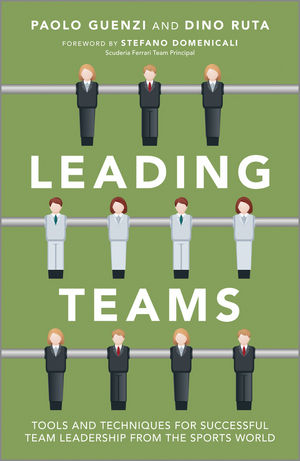Title: Leading Teams: Tools and Techniques for Successful Team Leadership from the Sports World
Authors: Paolo Guenzi, Dino Ruta
ISBN: 978-1-118-39209-6
Our reviewer this time was David Evans of Burn Bridge Associates.

This 330-page book has an easy-read style and will be of interest to anyone with sporting inclinations. Its sub-title, “Tools and techniques for successful team leadership from the sports world”, describes accurately its theme and content. From the off, it establishes a direct link between the two worlds, of business and sport. Sensibly, its first chapter points out the key differences between the two and offers words of caution about making too strong a link. After all, the make-up and operations of teams in business differ widely from those in the sporting context. It also highlights the fundamental difference in the way that the two sectors define and measure success.
So, this approach raises a couple of questions: (i) isn’t sport a sub-set of the larger world of commerce and business? And, (ii) isn’t it dangerous to generalise too far about the business of sport, given the vast differences in sporting commercial success? Both questions are valid and not really covered in this book. Indeed, as the reader progresses, it is clear that the real focus is on how sports coaches manage their teams, and the commercial outcomes are largely ignored after the opening chapter of caveats.
To launch the main part of the book, the authors draw up a useful table of characteristics linking the business team with its sporting counterpart (p31); the contents of which should be familiar to most business readers. It is here that the authors also outline their main objectives for this work: to identify the competencies that coaches of sports teams use to manage; to link these with models used in business; to assess the transferability of these to the business world.
Defining leadership as “the ability of individuals to influence, motivate and enable others to contribute toward the success of the organisation of which they are members”, chapter 2 summarises the current thinking on leadership from the management sciences. The authors conclude that relational leadership is most apposite as a model that satisfies team leadership in both the sports and the business world. In chapter 3 the authors present their model of leadership, giving particular focus on leader-credibility as a critical precursor to enhanced team performance. They posit that credibility is a function of technical competence, energy, fairness and consistency.
In depth interviews with professional coaches also lead the authors to suggest that situational, coaching and stakeholder considerations are very important. The overriding thought from the main body of this book – chapters 3, 4 and 5 – is that personal leadership and an obsession with detail are what differentiate the great coaches in the sports world. Also high on the list of important factors is the importance of satisfying stakeholders.
The authors develop some useful frameworks for results and motivation (p.180 and 194) and I like the way that they have drawn theories from academic research – like the theory of flow and goal-setting theory – to give their sports-world observations some weight and context. I also learned about the phenomenon of ‘social loafing’, a term used to describe the behaviour of team members when they observe some of their team-mates not trying to do their best: the result of which can be that the observers make less of an effort. This usually creates a downward spiral in team performance: in the sporting world this might be described as a team going on a losing streak.
I think that perhaps the most valuable lesson from this book is the importance of social interdependency – a concept long-argued in the team theory world and the tension that faces coaches of sports teams. Co-operation maximises performance; whereas individuals tend to maximise their own performance and fierce competitors tend to want to out-perform their team-mates.
Reviewer’s rating
This book has an interesting perspective on team leadership, written in an accessible style and with the theoretical basis that ensures its own credibility. It offers up its own frameworks for practical team leadership and additionally provides a useful summary of mainstream leadership theory.
It also provides a myriad of examples of good and poor leadership in sport, with supporting quotes from such luminaries as Emilio Sanchez (tennis), Carlo Ancelotti, Roberto Mancini and Sir Alex Ferguson (Football) and John Kirwan (Rugby Union).
I think this is a useful book for HR professionals to know about; not because it will necessarily help them personally to do a better job on a day-to-day basis. Rather, this will aid managers in your client groups, because it a great read that will help to guide their approach to leadership, without being too tedious to learn from.
Rating: 3 out of 5.











